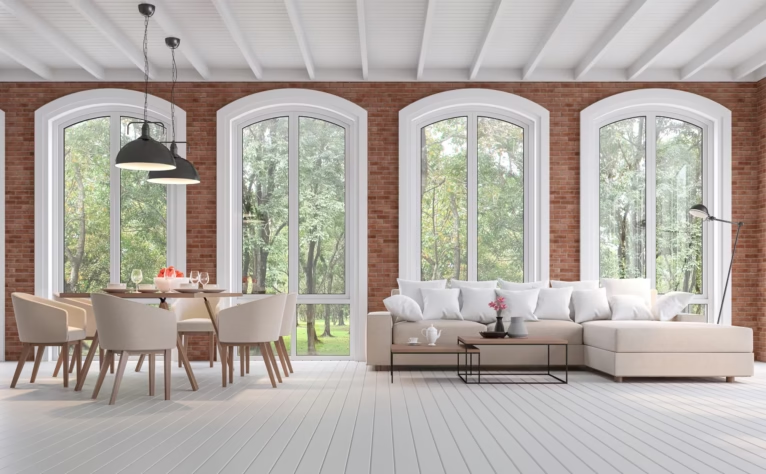When planning a room’s design, most people focus on the walls, floors, and furnishings—often overlooking the ceiling. But in design, the ceiling is your “fifth wall,” and a well-designed ceiling can dramatically enhance the entire space. From subtle architectural detailing to bold color or lighting treatments, the ceiling offers a vast and often underutilized canvas.
This article explores innovative ceiling design ideas that elevate your interiors, add depth, and tie together your overall design vision.
Why Ceiling Design Matters
- Enhances room character and dimension
- Defines zones in open-plan layouts
- Boosts perceived height or coziness
- Supports acoustic and lighting strategies
- Adds luxury or drama without taking up floor space
Table: Ceiling Types vs. Design Options
| Ceiling Type | Design Enhancements | Visual Effect | Best Room Fit |
|---|---|---|---|
| Flat Ceiling | Paint, wallpaper, molding | Clean and versatile | Bedrooms, living rooms |
| Vaulted Ceiling | Wood beams, skylights | Expansive, architectural | Great rooms, lofts |
| Coffered Ceiling | Grids, insets, lighting | Formal, dramatic | Dining rooms, offices |
| Tray Ceiling | Recessed paint, LED lights | Adds height and depth | Bedrooms, dining areas |
| Sloped/Cathedral | Exposed beams, wood panels | Rustic, spacious | Cabins, mountain homes |
Design Ideas for Different Ceiling Types
1. Painted Ceilings
- Use contrasting or bold hues for drama
- Match ceiling paint to wall color for unity
- Pastel ceilings for subtle elegance in nurseries or bedrooms
2. Wood-Clad Ceilings
- Use planks, panels, or reclaimed wood
- Works well in rustic, farmhouse, and Scandinavian interiors
- Pair with white walls to highlight the texture
3. Coffered and Beamed Ceilings
- Add depth and traditional charm
- Paint in tonal variations for a modern twist
- Use recessed lighting within coffer grids
4. Wallpapered Ceilings
- Perfect for powder rooms, entryways, or kids’ spaces
- Choose bold prints or metallics
- Use textured wallpaper (e.g., grasscloth) for warmth
5. Exposed Ducts and Industrial Ceilings
- Paint ducts and beams in matte black or charcoal gray
- Keep finishes raw for loft-style appeal
6. Plaster or Decorative Molding
- Use for elegance in classical or transitional interiors
- Combine with chandelier lighting for extra luxury
Lighting as a Design Element
Ceiling design often works hand in hand with lighting. Try these strategies:
- Recessed lights: Sleek and practical
- Pendant lights: Add focal points and sculptural detail
- Chandeliers: Grand statements for high ceilings
- Cove lighting: Subtle ambient glow around tray ceilings
- Backlit panels: Modern and futuristic touch
Room-by-Room Ceiling Tips
Living Room
- Use wood beams or painted insets to draw the eye upward
- Add a central lighting fixture for visual weight
Kitchen
- Coffered ceiling with recessed lighting for task zones
- Consider acoustic panels in open-concept spaces
Bedroom
- Use soft tones or dimmable LED lighting for restfulness
- Tray ceilings with subtle gradients add calm sophistication
Bathroom
- Paint ceilings in a lighter shade of wall color
- Use moisture-resistant materials for ventilation zones
Entryway or Hallway
- Metallic wallpaper or bold paint for a surprising reveal
- Add statement pendant lighting to draw attention upward
Materials to Consider
- Wood (planks, reclaimed beams)
- Gypsum board (moldings, tray ceilings)
- Metal (pressed tiles, modern accents)
- Acoustic tiles (sound-dampening in offices or studios)
- Textured paint finishes
Sustainability in Ceiling Design
- Use FSC-certified wood
- Opt for natural or recycled materials (e.g., cork, reclaimed tin)
- Choose low-VOC paints and adhesives
Mistakes to Avoid
- Using overly dark colors in low-ceiling spaces
- Installing oversized fixtures without considering scale
- Ignoring ceiling height in design planning
- Forgetting acoustic impact in open layouts
Budget-Friendly Ceiling Enhancements
- Paint only the ceiling tray or molding for accent
- DIY wood plank kits or peel-and-stick panels
- Install medallions under light fixtures for classic detail
The ceiling has long been the unsung hero of interior design. When treated as an intentional design element, it can unify a space, create architectural interest, and add emotional resonance to a room. Whether you opt for beams, lighting, texture, or color, ceiling design offers an incredible opportunity to elevate your interiors—literally and stylistically.
So next time you plan a room makeover, don’t stop at eye level. Look up—and let the fifth wall inspire your next design transformation.


Leave a Reply